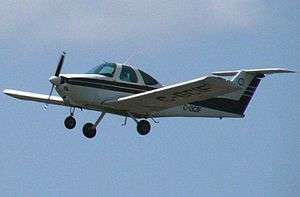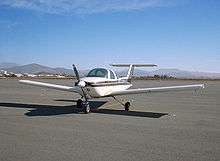Beechcraft Skipper
| Beechcraft Model 77 Skipper | |
|---|---|
 | |
| Role | Light utility aircraft |
| Manufacturer | Beech Aircraft Corporation |
| First flight | September 12, 1978 |
| Introduction | 1979 |
| Produced | 1979-1981 |
| Number built | 312 |
The Beechcraft Model 77 Skipper is a two-seat, fixed tricycle gear general aviation airplane, originally designed for flight training but also used for touring and personal flying.[1][2]
Design and development
The Skipper was conceived with the design goals of creating a low acquisition cost primary trainer with an emphasis on ease of maintenance and low operating costs.[2]
Design work on the Skipper began in 1974 as the PD 285,[3] which made its maiden flight on February 6, 1975.[2][4] The Skipper was Beechcraft's attempt to enter the two-place trainer market with an aircraft capable of competing with the popular Cessna 150 line of trainer aircraft. Though the aircraft first flew with a standard tail configuration, by the time it entered production, a T-tail configuration had been adopted, giving it an appearance very similar to its close competitor, the Piper PA-38 Tomahawk of 1978 to 1982.[1][2]
Like the Cessna and Piper trainers which were its primary competition, the Skipper utilizes the Lycoming O-235 engine and features side-by-side configuration seating.[2]
The Skipper wing utilizes a GA(W)-1 airfoil,[3] specifically developed for low-speed aviation applications, based on 1970s NASA research.[2] The aircraft was certified for intentional spins.[3] While it is an all-metal design, the Skipper incorporates a number of innovative construction techniques, including honeycomb bonding, tubular spars, and a hot-bonded wing structure. The flaps and ailerons are actuated by torque tubes, rather than cables.[2] The landing gear is mounted to the fuselage/wing junction, but has a 5.17 ft (2 m) wide wheelbase, giving it a "spraddle-legged" appearance on the ground.[1]
Operational history
.jpg)
The Skipper had the misfortune of being introduced at the beginning of a severe downturn in general aviation aircraft production in the United States. During its first year 1979, 47 were built, 140 in 1980, and 125 in 1981.[3] A total of 312 aircraft were built.
Most of the production run was initially delivered to Beechcraft's flight school network, the Beech Aero Centers, where they were used as primary trainers.[1] A handful of Skippers are still in use as trainers. Many others are in the hands of private owners who use them as touring aircraft.
Specifications

Data from Jane's All The World's Aircraft 1980–81[5] and Observer's Book of Aircraft 1981[2]
General characteristics
- Crew: 2
- Length: 24 ft 0 in (7.32 m)
- Wingspan: 30 ft 0 in (9.14 m)
- Height: 7 ft 11 in (2.41 m)
- Wing area: 129.8 ft² (12.1 m²)
- Airfoil: GA(W)-1
- Empty weight: 1,100 lb (499 kg)
- Max. takeoff weight: 1,675 lb (760 kg)
- Powerplant: 1 × Lycoming O-235-L2C flat-4 engine, 115 hp (86 kW)
Performance
- Cruise speed: 105 knots (121 mph, 195 km/h)
- Stall speed: 47 knots (54 mph, 87 km/h) (flaps down)
- Range: 412 nmi (475 mi, 764 km) at 8,500 ft (2,600 m) (econ cruise)
- Service ceiling: 12,900 ft (3,930 m)
- Rate of climb: 720 ft/min (3.65 m/s)
See also
- Aircraft of comparable role, configuration and era
- Cessna 150
- Cessna 152
- Grumman American AA-1
- Liberty XL2
- Piper PA-38 Tomahawk
- Symphony SA-160
- Whitney Boomerang
References
- Notes
- 1 2 3 4 Montgomery, M.R. and Gerald Foster: A Field Guide to Airplanes, Second Edition, page 26. Houghton Mifflin Company, 1992. ISBN 0-395-62888-1
- 1 2 3 4 5 6 7 8 Green, William: Observers Aircraft, pages 40-41. Frederick Warne Publishing, 1981. ISBN 0-7232-1618-5
- 1 2 3 4 Phillips, Edward H., Beechcraft - Staggerwing to Starship. Flying Books, 1987. ISBN 0-911139-06-0.
- ↑ Air Enthusiast December 1975, p. 312.
- ↑ Taylor 1980, p. 265.
- Bibliography
- "Airdata File: Beechcraft PD 285". Air Enthusiast, December 1975, Vol 9 No 6. p. 312.
- Taylor, John W. R. Jane's All The World's Aircraft 1980–81. London: Jane's Publishing Company, 1980. ISBN 0-7106-0705-9.
- Type certificate data sheet no. A30CE. Revision 5. (Mar 26, 2007) Department of Transportation. Federal Aviation Administration
External links
| Wikimedia Commons has media related to Beechcraft Model 77. |